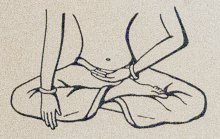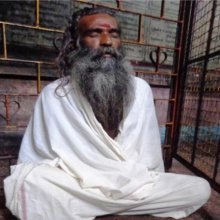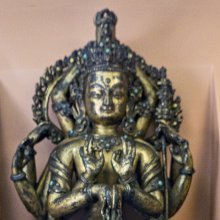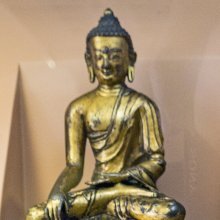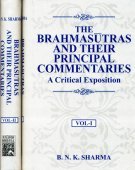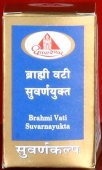Meditation: 5 definitions
Introduction:
Meditation means something in Hinduism, Sanskrit, the history of ancient India. If you want to know the exact meaning, history, etymology or English translation of this term then check out the descriptions on this page. Add your comment or reference to a book if you want to contribute to this summary article.
Images (photo gallery)
(+19 more images available)
In Hinduism
Yoga (school of philosophy)
Source: ORA: Amanaska (king of all yogas): A Critical Edition and Annotated Translation by Jason BirchMeditation (in Sanskrit: dhyāna) is achieved by dissolving the mind, according to Bhāgavatotpala’s Spandapradīpikā on 31.—The ‘dissolution’ of the mind was a description of the meditative process itself, as seen for example in Bhāgavatotpala’s definition of meditation (dhyāna): “When the mind has dissolved (līna) in the object of meditation, then that is said to be meditation”.

Yoga is originally considered a branch of Hindu philosophy (astika), but both ancient and modern Yoga combine the physical, mental and spiritual. Yoga teaches various physical techniques also known as āsanas (postures), used for various purposes (eg., meditation, contemplation, relaxation).
Natyashastra (theatrics and dramaturgy)
Source: Shodhganga: Elements of Art and Architecture in the Trtiyakhanda of the Visnudharmottarapurana (natya)Meditation is associated with Dolā-hasta: one of the thirteen Combined-hand Gestures (in Indian Dramas) (known as saṃyuktahastas), according to the Viṣṇudharmottarapurāṇa, an ancient Sanskrit text which (being encyclopedic in nature) deals with a variety of cultural topics such as arts, architecture, music, grammar and astronomy.—According to the Śabdakalpadruma, dolā means a kind of swing playing stuff, generally stays in gardens and made with wood. When both of the hands are hanging downward in patāka posture it is called dolā. This posture signifies meditation, giving charity and edible things.

Natyashastra (नाट्यशास्त्र, nāṭyaśāstra) refers to both the ancient Indian tradition (shastra) of performing arts, (natya—theatrics, drama, dance, music), as well as the name of a Sanskrit work dealing with these subjects. It also teaches the rules for composing Dramatic plays (nataka), construction and performance of Theater, and Poetic works (kavya).
Shilpashastra (iconography)
Source: Shodhganga: Elements of Art and Architecture in the Trtiyakhanda of the Visnudharmottarapurana (shilpa)Meditation is associated withe the Sentiment of Quietism (śānta), which refers to one of the Nine Sentiments (citrarasa) in ancient Indian Painting (citra), according to the Viṣṇudharmottarapurāṇa, an ancient Sanskrit text which (being encyclopedic in nature) deals with a variety of cultural topics such as arts, architecture, music, grammar and astronomy.—The śāntarasa is depicted through the picture of the ascetic people sitting in Yogic posture or meditation. [...] Thus, painting is a medium of showing the inner feelings and emotions of a painter which can strikes the inherent sentiments of connoisseur’s mind, for example: meditation in the sentiment of quietism.

Shilpashastra (शिल्पशास्त्र, śilpaśāstra) represents the ancient Indian science (shastra) of creative arts (shilpa) such as sculpture, iconography and painting. Closely related to Vastushastra (architecture), they often share the same literature.
Pancaratra (worship of Nārāyaṇa)
Source: Shodhganga: Kasyapa Samhita—Text on Visha Chikitsa (p)Meditation is denoted by the Sanskrit term Yoga and represents one of the principal topics of the Pāñcarātra division of the Vaiṣṇava Āgamas.—The almighty Hari, out of compassion for mankind in general, felt that the Vedas and Śāstras could not be easily grasped and practised by people belonging the diverse communities and cadres, whose potential and comprehension would vary vastly. Hence, he promulgated the Pāñcarātra doctrine [teaching for example yoga—meditation] which is the essence of the Vedas, in a simplified form.

Pancaratra (पाञ्चरात्र, pāñcarātra) represents a tradition of Hinduism where Narayana is revered and worshipped. Closeley related to Vaishnavism, the Pancaratra literature includes various Agamas and tantras incorporating many Vaishnava philosophies.
India history and geography
Source: Singhi Jain Series: Ratnaprabha-suri’s Kuvalayamala-katha (history)Meditation was practised by those pursuing the spiritual life in the Hermitages (or Ashrams) of ancient India, as vividly depicted in the Kathās (narrative poems) such as Uddyotanasūri in his 8th-century Kuvalayamālā (a Prakrit Campū, similar to Kāvya poetry).—Page 87.20-28: Here is a vivid description of the intellectual and spiritual life in the Aśrama of a Jaina Muni. Uddyotanasūri gives a list of twenty-one methods of study and discussions and approaches to the tenets of religion and philosophy, [e.g., practising meditations] [...]. Also see the description of the hermitage of Divākara Mitra described by Bāṇa in the Harṣacarita.

The history of India traces the identification of countries, villages, towns and other regions of India, as well as mythology, zoology, royal dynasties, rulers, tribes, local festivities and traditions and regional languages. Ancient India enjoyed religious freedom and encourages the path of Dharma, a concept common to Buddhism, Hinduism, and Jainism.
See also (Relevant definitions)
Ends with: Three kinds of Meditation.
Full-text (+5165): Dhyana, Samadhi, Dhyanayoga, Pranidhana, Yoga, Antardhyana, Anudhyana, Rajayoga, Bhavana, Three Meditations, Anuyoga, Yogaja, Samadhistha, Brahmasana, Kammatthana, Dhyanastha, Yogasana, Bhadrasana, Paramahamsa, Dhyanakoti.
Relevant text
Search found 441 books and stories containing Meditation; (plurals include: Meditations). You can also click to the full overview containing English textual excerpts. Below are direct links for the most relevant articles:
Brahma Sutras (Ramanuja) (by George Thibaut)
Sutra 3.3.56 < [Third Adhyaya, Third Pada]
Sutra 3.3.55 < [Third Adhyaya, Third Pada]
Sutra 3.3.23 < [Third Adhyaya, Third Pada]
Brahma Sutras (Shankaracharya) (by George Thibaut)
III, 3, 57 < [Third Adhyāya, Third Pāda]
IV, 1, 7 < [Fourth Adhyāya, First Pāda]
IV, 1, 12 < [Fourth Adhyāya, First Pāda]
Brahma Sutras (Nimbarka commentary) (by Roma Bose)
Brahma-Sūtra 3.3.41 < [Adhikaraṇa 18 - Sūtra 41]
Brahma-Sūtra 1.3.31 < [Adhikaraṇa 8 - Sūtras 31-33 (opponent’s view)]
Brahma-Sūtra 3.3.55 < [Adhikaraṇa 23 - Sūtra 55]
Brahma Sutras (Shankara Bhashya) (by Swami Vireshwarananda)
Chapter IV, Section III, Adhikarana VI < [Section III]
Chapter III, Section III, Adhikarana XXVIII < [Section III]
Chapter IV, Section I, Adhikarana V < [Section I]
Taittiriya Upanishad Bhashya Vartika (by R. Balasubramanian)
Verse 1.135 < [Book 1 - Śīkṣāvallī]
Verse 1.54 < [Book 1 - Śīkṣāvallī]
Verse 1.61 < [Book 1 - Śīkṣāvallī]
Vipassana Meditation Course (by Chanmyay Sayadaw)
Part 3 - Four Protective Meditations < [Chapter 1 - Preliminary Stage]
Part 1 - Samatha And Vipassana Meditation < [Chapter 1 - Preliminary Stage]
Related products
(+8 more products available)
